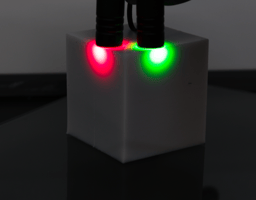When you press a pulse oximeter against your finger, the tissue deforms. When a surgeon navigates...
Full-Spectrum Optical Measurements in Tissue and Phantoms
If you're building an optical medical device (e.g., pulse oximeters, surgical guidance tools, glucose monitors or photodynamic therapy systems) you need to understand tissue optical properties. It's not just nice to know, it's essential. Your device might work perfectly on phantoms in the lab, but real tissue? That's a different story.
QUEL Imaging uses spectrophotometry to help clients measure their target optical properties and develop accurate tissue-equivalent phantoms to accelerate device development cycles in R&D. Here, we will discuss why and how we do this.
Why Optical Properties?
Biological tissues are messy. They absorb light (thanks to hemoglobin, melanin, water), scatter it off cellular structures (lipids and proteins), and vary wildly from patient to patient. For your device to work reliably having a quantitative basis for photon transport (i.e., absorption coefficient [μₐ] reduced scattering coefficient [μₛ']) across all relevant light colors helps understand and inform device design.
These optical properties directly impact your device’s technical specs and real-world performance. How deep does your light penetrate? What's your signal-to-noise ratio? How much light power do you need for your measurements? Without proper characterization, you're flying blind.
There are several ways to measure optical properties, which we covered in detail here. Today, we're going to focus on spectrophotometry, which we use the most at QUEL.
Spectrophotometry: Measuring Reflectance and Transmittance
A spectrophotometer instrument contains a light source, a method of changing illumination color (wavelength), one or two integrating spheres to capture all of the reflected or transmitted light from the sample, and a sensitive photodetector to measure how much light is present after illumination. These instruments will give you two main sets of data:
- reflectance (light bouncing off of tissue) as a function of light color (wavelength)
- transmittance (light passing through tissue) as a function of light color (wavelength)
With a little math, we can transform these reflectance and transmittance measurements into absolute generalizable absorption and scattering properties.
A lot of work goes into sample preparation, mounting, and baseline referencing for each measurement - typically along with plenty of troubleshooting and head-scratching. Clean, accurate baseline references and sample preparation are critical to measurement accuracy. 
The data we get from a typical tissue-mimicking sample is shown at the right.
With reflectance and transmittance measurements, we can move on to computationally derive the generalized optical properties. But it all starts here with accurate spectrophotometry data.
To learn how we calculate general absorption and scattering properties, check out our blog post on the inverse adding doubling (IAD) algorithm that we use.
You can also read more about Scott Prahl’s IAD Algorithm on his lab's site.
Summary
Optical properties measurements can be tricky - but with the right planning, tools, and framework, the possibilities are endless.
There’s no need to go at it alone. Our team has decades of combined experience in material optical property characterization of biomedical applications. Reach out today to learn how we can help get your projects set up for success through analytical services or custom phantom design.



